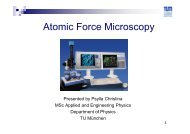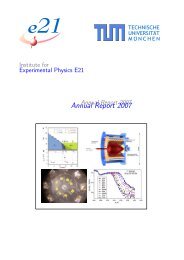Annual Report 2011 / 2012 - E21 - Technische Universität München
Annual Report 2011 / 2012 - E21 - Technische Universität München
Annual Report 2011 / 2012 - E21 - Technische Universität München
You also want an ePaper? Increase the reach of your titles
YUMPU automatically turns print PDFs into web optimized ePapers that Google loves.
32 <strong>E21</strong> <strong>Annual</strong> <strong>Report</strong> <strong>2011</strong>/<strong>2012</strong><br />
Thin Film Alloying Studied by CDBS with the NEPOMUC Positron Beam<br />
Markus Reiner 1, 2 , Philip Pikart 1, 2 , Christoph Hugenschmidt 1, 2<br />
1 Physik-Department <strong>E21</strong>, <strong>Technische</strong> Universität München, D-85748 Garching, Germany.<br />
2 Forschungsneutronenquelle Heinz Maier-Leibnitz (FRM II), <strong>Technische</strong> Universität München, D-85748 Garching, Germany.<br />
Coincident Doppler Broadening Spectroscopy (CDBS) enables<br />
the detection of high momenta of strongly bound core<br />
electrons and hence, reveals the chemical environment of the<br />
positron annihilation site on an atomic scale. Using the highintensity<br />
NEPOMUC positron beam at the FRM II enables<br />
CDBS as function of both implantation depth and temperature.<br />
This unique experimental technique offers a great<br />
potential for the investigation of the structure and kinematics<br />
in multilayer systems such as annealing, interdiffusion<br />
and thin film alloying. The element selectivity of these studies<br />
can be further increased by the ab-initio calculation of<br />
CDB spectra.<br />
Ab-initio calculation of CDB spectra<br />
For the calculation of CDB spectra, the momentum distribution<br />
ρ(p) of the annihilating electron-positron-pair<br />
ρ(p) = πr0c ∑ ∫<br />
2<br />
2 u 2 j(0)<br />
∣ dr e −ip·r ψ + (r)ψ j (r)<br />
∣ (1)<br />
j<br />
is determined within a two-component density functional<br />
theory [1]. In the limit of a vanishing positron density, ψ + is<br />
obtained by solving the positron´s Schrödinger equation in<br />
the bulk. Its charge density is described by an atomic superposition<br />
method of electronic wavefunctions ψ j . Electronpositron<br />
correlations are described by the state-dependent<br />
enhancement factoru j (0) and modeled by a generalized gradient<br />
approximation. The measured momentum distribution<br />
ρ(p) is given as sum of all orbital momentum distributions;<br />
r 0 denotes the classical electron radius.<br />
The presented calculational method accounts for the annihilation<br />
with (semi-)core electrons. Hence, the calculated<br />
well describe the element-specific signature in the High Momentum<br />
Area (HMA) of CDB spectra.<br />
Au/Cu interdiffusion<br />
The vast range of applications of thin film systems and their<br />
continuous downscaling demand a detailed understanding of<br />
microscopic processes. For this, positrons with their high<br />
defect sensitivity reveal not only unique information about<br />
defect-related processes like annealing [2], but also about<br />
structural changes by the use of depth-dependent and insitu<br />
CDBS at elevated temperature. Hence, this experimental<br />
technique, which requires a high-intensity positron beam,<br />
is an outstanding tool for the investigation of thin film annealing<br />
and alloying at the interface on the same time.<br />
In a comprehensive study, the tempering of a vapor deposited<br />
bilayer Au (180 nm)/Cu (480 nm) on a Si substrate was<br />
investigated by depth-dependent and in-situ CDBS for the<br />
first time [3]. In both layers, the grain size was determined<br />
to be 30±10 nm by XRD-spectroscopy. During tempering,<br />
in-situ CDBS with an positron implantation energy of 9 keV<br />
(which corresponds to implantation of positrons on the topmost<br />
Au layer close to the Au/Cu interface) was performed<br />
at three different temperatures: 633 K, 683 K and 733 K.<br />
During tempering at 633 K, the following two stages were<br />
identified: In the first three hours, mainly annealing was<br />
detected and the initial grain boundary diffusion of Cu atoms<br />
into the Au film only slightly affected the measured spectra.<br />
In the following four hours, the spectra slowly approached<br />
that taken at 683 K and 733 K, where the sample was found<br />
to be in thermal equilibrium. The latter both measured spectra<br />
were compared with theoretical calculations.<br />
The CDB spectra for the disordered fcc phase of<br />
(Au,Cu) with a varying Au content between 20 % and 90 %<br />
were calculated (figure 1). At both temperatures, excellent<br />
agreement was found for an Au content of 70 %. Hence, it<br />
can be concluded that during the second tempering stage<br />
observed at 633 K a homogenization of Au and Cu atoms<br />
took place leading to the formation of Au 0.7 Cu 0.3<br />
CDB ratio to Cu<br />
0.8<br />
0.7<br />
0.6<br />
0.5<br />
0.4<br />
4.5 5.0 5.5 6.0 6.5 7.0 7.5 8.0 8.5<br />
Au content<br />
0.9<br />
0.8<br />
0.7<br />
0.6<br />
0.5<br />
0.4<br />
0.3<br />
0.2<br />
Doppler shift (keV)<br />
18 20 22 24 26 28 30 32 34<br />
longitudinal momentum component (10 -3 m 0<br />
c)<br />
Figure 1: HMA of the CDB ratio curve at 733 K at the Au/Cu<br />
interface. Calculational results display an Au content of around<br />
70 %.<br />
Depth-dependent CDBS before and after tempering confirmed<br />
that the topmost Au layer was replaced by a homogeneous<br />
intermixing zone of Au 0.7 Cu 0.3 . Below this intermixing<br />
zone, a high amount of Cu was detected as well. Hence, both<br />
layers did not totally mix up. Furthermore, the kinematics of<br />
the observed process indicate that the initial movement of<br />
Cu atoms along grain boundaries accelerated the intermixing<br />
[3].<br />
References<br />
[1] M. J. Puska and R. M. Nieminen, Rev. Mod. Phys. 66, 841 (1994).<br />
[2] M. Reiner, P. Pikart, and C. Hugenschmidt, Phys. Procedia 35,<br />
104 (<strong>2012</strong>).<br />
[3] M. Reiner, P. Pikart, and C. Hugenschmidt, to be published.




